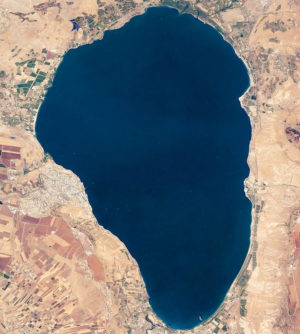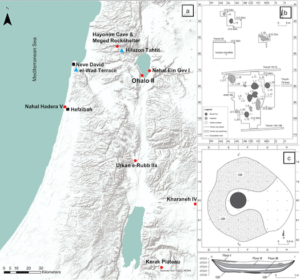
PLOS—As climate shifted 23,000 years ago, humans in Israel experienced a new abundance of food, according to a study published January 26, 2022 in the open-access journal PLOS ONE by Tikvah Steiner of the Hebrew University of Jerusalem and colleagues.
The submerged archaeological site of Ohalo II, located on the southern tip of the Sea of Galilee in Israel, preserves extensive evidence of human occupation about 23,000 years ago. This was a time period of global climate fluctuation, and also a time when humans notably diversified their dietary habits. Some researchers have suggested this diet shift was necessary due to decreasing food availability, while others suggest the change was an opportunistic one made possible by increasing food abundance. In this study, Steiner, Nadel and colleagues from a multidisciplinary team from four Israeli and Spanish universities tested these competing hypotheses via analysis of animal remains at Ohalo II.

Early Epipaleolithic sites are marked with red circles, Middle Epipaleolithic with black squares and Late Epipaleolithic with blue triangles. Steiner et al., 2022, PLOS ONE, CC-BY 4.0 (https://creativecommons.org/licenses/by/4.0/)
The authors examined over 20,000 animal remains, including reptiles, birds, and mammals, from well-preserved successive floors of a brush hut at the site. The results show that the people of Ohalo II were successfully hunting prime large game, while at the same time gathering a wide variety of fish, other small animals, and plants.
According to the authors, this evidence does not indicate a drop in food availability, but rather an abundance of multiple prey sources. They suggest that while some animals were gathered for meat, others might have been hunted for pelts (e.g.: foxes, hares) or shells (e.g.: tortoises). From this study, it seems that fluctuating climate conditions did not create food stress, at least in this region, but instead new dietary opportunities. The researchers hope that this work at Ohalo II will serve as a model for similar investigations of human diet changes at other locations and time periods.
The authors add: “The choice of a littoral habitat that could be intensively exploited year-round may be an example of niche selection. The availability of multiple food sources within a rich habitat may have driven exploitation of myriad local resources, rather than targeting mainly energetically-rich large prey.”
_________________________________
Article Source: PLOS news release.
*Steiner T, Biton R, Nadel D, Rivals F, Rabinovich R (2022) Abundance or stress? Faunal exploitation patterns and subsistence strategies: The case study of Brush Hut 1 at Ohalo II, a submerged 23,000-year-old camp in the Sea of Galilee, Israel. PLoS ONE 17(1): e0262434. https://doi.org/10.1371/journal.pone.0262434
Funding: This study was supported partly by scholarships awarded to T.S. by the Institute of Archaeology, Hebrew University of Jerusalem, Israel to M.A. students and the Ruth Amiran Scholarship. Field work was supported by grants from the Israel Science Foundation (Nos. 831/00 and 711/08), Jerusalem Center for Anthropological Studies, L.S.B. Leakey Foundation, MAFCAF Foundation, National Geographic Society, Stekelis Museum of Prehistory in Haifa, and the Israel Antiquities Authority. The funders had no role in study design, data collection and analysis, decision to publish, or preparation of the manuscript.
_________________________________
Advertisement



